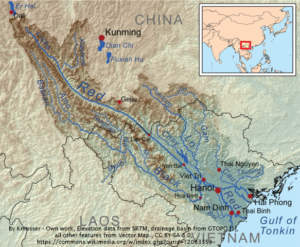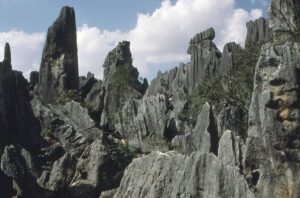Early History
The Tai Kingdom of Nanchao
According to Chinese records, civilizations once known as “Kun-ming” and “Ai-lao” were found to have existed in the area now known as the Yunnan Province of China. They formed separate small entities and fought among themselves. By the middle of the seventh century, six petty kingdoms around the Erh-hai Lake in today’s Tali region joined themselves into a stronger kingdom named Nanchao (known as Nong Sae in Lao and Thai). Those smaller kingdoms were known as: Meng-sui, Yueh-his, Teng-t’an, Shih-lang, Lang-ch’iung, and Meng-she(1). Many historians have concluded that the people of Ai-Lao, which was later known as Nanchao, were of a Tai race. However, this theory remains in controversy today.
The Nanchao kingdom became stronger and occasionally formed alliances with Tibet and the Empire of China, which was then under the T’ang Dynasty. However, during this period, Nanchao made many incursions into China’s territory. And vice versa, China struck many of Nanchao’s towns and cities. After a defeat by the T’ang army in 779 A.D., Nanchao built a fortress city named Yang-hsieh-mieh (modern day Tali), and made it their capital(2). A century later, after conquering the Ts’uan people in the Eastern part of Yunnan and annexing their territory, Nanchao established an “Eastern Capital” named Che-tung (modern day Kunming)(3) .
After expanding to Eastern Yunnan, Nanchao engaged in further campaigns of conquest. They attacked: Pyu in 832 A.D. and Mi-ch’en in 835 A.D., both of today’s Myamar; the Khmers of Chen-la (today’s Cambodia); Po-chou (today’s Kweichow of China) in 859 A.D.; Annam (today’s Vietnam, then under China) in 860 A.D.; Yung-chou (today’s Kwangsi of China) in 861 A.D.; and again Annam in 862 A.D. (4) .
With an army of 50,000 soldiers, Nanchao overran Annam (Vietnam) and captured Hanoi in the winter of 862 A.D. (5) Nanchao forces killed or captured 150,000 Chinese and Vietnamese T’ang subjects. (6) However, in 866 A.D., a Chinese commander named Kao-P’ien, with reinforcements from China, defeated and repulsed the Nanchao army from Annam. Thirty-thousand Nanchao soldiers were killed.
The Nanchao Kingdom may or may not have been a Tai kingdom, but the 862 A.D. conquest of Hanoi and the defeat of the Nanchao army in 866 A.D., followed by the Tai expedition to seek new lands, presented conditions that gave birth to a new Tai kingdom.
The Legend of Nam Taw Pung
(Nam Taw Pung: a large elongated gourd)
[Verses selected from “Kwaam To Meuang” or the “Tai Chronicle” for this booklet]
This is the story of our Land.
In the beginning, the earth and the grass were formed.
The sky was as small as a mushroom.
The seven lands were shaped.
There were nine waters which met a the mouth
Of the Tae, Taav, Ou, and Khoong Rivers (Black River, Red River, Nam Ou, & Mekong)
~~~~~ Verses omitted ~~~~~
Once again, the Sky (God) planned
To send people to the Earth below.
The Sky placed everything in eight Pung-gourds.
There were thirty clans of hill people.
There were fifty clans of Tai people.
There were three hundred thirty kinds of rice for the fields.
There were five hundred fifty kinds of fish for the waters.
There was every kind of animal stock,
Bred in the water and on the land,
That knew how to fly, creep or crawl.
There were sacred manuscripts of priests and shaman
And of astrologers and prophets.
There were the old traditions,
The Twelve village-customs,
And the Twenty-four kingdom-laws.
The Sky placed them all in the Pung-gourds
The Almighty Thaen (God) allowed
Princes Tao Souang (Taav Suang) and Tao Ngeun (Taav Ngern)
To take down the eight Pung-gourds
And eight brass pillars supporting the sky.
They reached the lands of Meuang Om and Meuang Ay
They were delayed on the paths and on the roads,
For the water had not yet dried.
~~~~~ Verses omitted ~~~~~
Tao Souang and Tao Ngeun came down
To the Daan-Kaev-Euang Rocks
The rocks moved like jaws,
Snapping and cracking.
Thirty senior sorceresses tried to stop the snapping
And fifty junior sorceresses tried to stop the rocks.
The rocks would not stop, the rocks would not listen.
Then, they took thirty loads of grapefruit,
And fifty loads of citrus to throw to the rocks.
The rocks felt its mouth hot, sour, bitter, and astringent.
So the rocks let its mouth open and stop snapping.
Tao Souang and Tao Ngeun let the buffalo down first.
The buffalo was not afraid and descended head first.
Thus its horns are bent backward.
They let the cow down next.
The cow was afraid and descended rear end first.
Thus its horns are curved to the front.
~~~~~ Verses omitted ~~~~~
At that time, they all reached the flat surface of the Earth.
Tao Souang and Tao Ngeun then reached Muong Lo (Meuang Lor)
Six Pung-gourds were sent to Muong Han (China),
With six brass pillars supporting the sky.
The last two gourds and two brass pillars
Were divided and sent to Muong Man (Burma),
Muong Lue (South of China), Muong Kaev (Vietnam),
Muong Lao (Laos), Muong Koy (Thailand),
Muong Nho (?), and Muong Bang (?).
~~~~~~~There are more verses, but they are not relevant to this booklet ~~~~~~
The Kingdom of Muong Lo
 According to certain sources, the main forces that fought along side the Nanchao army in 862-866 were Tai tribesmen: “In the mid-ninth century, Tai minority rebels in the border regions recruited the assistance of Nan-chao, a Tai mountain kingdom in the southern Chinese province of Yunnan, which seized control of Annam in 862.” (7)
According to certain sources, the main forces that fought along side the Nanchao army in 862-866 were Tai tribesmen: “In the mid-ninth century, Tai minority rebels in the border regions recruited the assistance of Nan-chao, a Tai mountain kingdom in the southern Chinese province of Yunnan, which seized control of Annam in 862.” (7)
After a legend of the Tai people in Northwest Vietnam, Tai people once battled with the Vietnamese and occupied Hanoi for some time. After a defeat, they retreated from Hanoi to the upland zones which were mostly uninhabited. They promised to return with a population to settle there by following this river of red water (today’s Red River of Vietnam). They named the river “Mae Nam Taav” which means “the River to Return.” Today, the Tai and local people in Southern China and in Vietnam still call this river “Mae Nam Taav”.
Referring back to the Tai Chronicle, the legend of the Nam Taw Pung (Pung-Gourds) is symbolic of some Nanchao commanders’ return with a population to settle. Princes Tao Souang and Tao Ngeun led a group of Tai people and other tribes as carriers or servants into today’s Northwest Vietnam after the 866 A.D. Nanchao defeat. On their journey, the two princes brought along large and small domestic animals, seeds of rice and plants, and manuscripts of customs, religious rites and the administration laws.
 The journey took them much longer than they expected, because of an enormous “flood” and their encounter with the “Daan Kaev Euang” or “Snapping Rocks”. “Snapping Rocks” is now believed to be the well-known “Stone Forest”, located in Lunan county of China’s Yunnan Province, about 200 kilometers north of Northwest Vietnam.
The journey took them much longer than they expected, because of an enormous “flood” and their encounter with the “Daan Kaev Euang” or “Snapping Rocks”. “Snapping Rocks” is now believed to be the well-known “Stone Forest”, located in Lunan county of China’s Yunnan Province, about 200 kilometers north of Northwest Vietnam.
In the Stone Forest, there is an opening in one of the rocks with a sign that reads “The Passage.” This passage was mentioned in the Tai Chronicle as “the rock’s mouth”, through which, with fear and difficulty, men and animals passed into another world, the Earth. (8)
Returning along Mae Nam Taav (The Red River) as promised, the expedition passed through a territory near today’s border of Vietnam and China. To mark their journey, they named the area Lao Cai (“Laav Kaay”) which means “where the Ai-Lao passed over.” Lao Cai is now a province in northwestern Vietnam. Also, about 5 kilometers north of Lao Cai, there is a town still named “Lao Phan” which means “where the Ai-Lao passed through.” Some Tai people still live there.
Princes Tao Souang and Tao Ngeun arrived with their followers in a place that was called Muong Lo (today’s Ngia Lo in Yen Bai Province, Vietnam). Most of the territory was uninhabited. Groups of indigenous tribal people known as the “Sa” and “Man” already lived there, but not united. Surprisingly, small groups of Tai people also lived there, and had been there for an unknown time. (9) The two princes ordered the settlement to be in that place and the Tai people called it the Kingdom of Muong Lo (Faen Din Meuang Lor). “Lor4″ is derived from the word “Lor2″, which means to create, manufacture or build.
That historic settlement took place in 870’s, a decade after the 866 A.D. Nanchao defeat. When the Vietnamese gained their independence from China in 939 A.D., they recognized the strength and independence of the Tai people. (10)
After some expansion and the establishment of towns and cities of the Kingdom of Muong Lo was completed, Prince Tao Ngeun returned to Meuang Om-Meuang Ai as before. According to a Chinese book, Muong Om and Meuang Ai (known in China as Houang-yen) are located in the territories of Cong Yan and Cong Leng inYunnan Province. (11) Prince Tao Souang remained in Muong Lo, got married, and conceived a son named Tao Lo after the name of the Kingdom.
When Prince Tao Lo reached the “adult” age of 15, his father anointed him King of Muong Lo, from which a “traditional constitution” has survived until the present time: “Sing Leuang Hay Yet Mo; Sing Lo Hay Yet Tao” is translated as “The Leuang clan are to be high priests, and the Lo clan are to be rulers.” From then on, all immediate members of the King Lo lineage have born the last name “Lo-Kam or LorKam” which means “Golden Lo.” The LorKam lineage has survived to the present time, but is known (Vietnamized) now as the Baccam, Cam, Deo, and Xa. (12) After the coronation of King Lo, his father, Prince Tao Souang returned to Meuang Om-Meuang-Ai as before. King Lo got married and conceived seven sons. These names may be slightly different in other versions of the Tai Chronicle:
1. Prince Taa Duk
2. Prince Taa Law
3. Prince Lap Li
4. Prince Lor Li
5. Prince Laang Ngaang
6. Prince Laang Kwaang
7. Prince Laan Cheuang (not Khun Cheuang of Sipsong-Panna)
When these princes reached adulthood, six of them were assigned to rule various cities of the Kingdom of Muong Lo. Only the last son, Prince Laan Cheuang, was left without a territory to govern. Prince Laan Cheuang counseled his father and the royal council as they created strategies to conquer more territory. King Lo granted the prince’s request for an expedition of population and army to gain more land.
Prince Laan Cheuang and his army then marched to and conquered many towns and cities: Muong Ming, Muong Lung, Muong Chian, Muong Chai, Muong La, Muong Muoi, and Muong Quai. After the conquest of each city, he appointed his lieutenants or the local leaders to be governors. However, these governors were to remain subordinate to his rule. Because these cities were either too small or unsuitable to be administrative centers, Prince Laan Cheuang continued his expedition. He finally arrived in the city of Muong Theng (Dien Bien Phu, in Vietnamese) where the land was level and wide.(13) Prince Laan Cheuang was pleased with the location and decided it would be the place for his settlement. He proclaimed himself King of the Kingdom of Muong Theng, which encompassed half of today’s Northwest Vietnam. The City of Muong Theng served as the Tai capital for only eight generations, and was ruled by a succession of seven kings.
Because of increasing infiltration by the Lao (today’s Laos) and Lue (Sipsong Panna of South-Yunnan) into Muong Theng, King Tao Theung moved the capital to Muong Muoi, further inside the country. Hence, the Kingdom of Muong Theng was changed to Kingdom of Muong Muoi. The Kingdom of Muong Muoi is referred to in the Tai Chronicle as “Faen Din Muong Muoi.” Muong Muoi city remained the capital of the Tai Country until the French colonization in 1888. Muong Muoi is now known in Vietnamese as Thuan Chau, a small city in Son La Province.(14)
SPECIAL NOTE: During the 13th century, Mongol warriors, led by Gengis Khan and later by his grandson Kublai-Khan, conquered the Empire of China and the Nanchao Kingdom. Nanchao was defeated in 1253 A.D. and was annexed to China by Kublai-Khan in 1255 A.D. (15) Some more Tai people fled south from the Nanchao Kingdom, and many tried to establish their own kingdom. Some failed and others succeeded, as in the past.
1. Kingdom of Muong Lo in 870’s A.D. (today’s Northwest Vietnam)
2. Kingdom of Shan in 1152 A.D. (today’s Shan States of Burma)(16)
3. Kingdom of Chiang Hung in 1180 A.D. (today’s Sipsong-Panna of Southern China)(17)
4. Kingdom of Ahom in 1227 A.D. (today’s Assam State of Northeast India)(18)
5. Kingdom of Sukhothai in 1238 A.D. (today’s Thailand)(19)
6. Kingdom of Lanna in 1259 A.D. (today’s Thailand)(20)
7. Kingdom of Lan Sang in 1353 A.D. (today’s Laos)(21)
REMARKS : All Tai Dam chronicles clearly state that King Lo, sometimes known as Khun Lo, had seven sons, and that the last one, Laan Cheuang, conquered Muong Theng. King Lo was born and died in Muong Lo. These statements may differ somewhat from the Lao myth which says: Khun Borom had seven sons, that all seven sons were sent to govern different kingdoms in Southeast Asia, except Muong Thaeng, and that Khun Borom’s oldest son, Khun Lo, governed the Kingdom of Chiang Dong-Chiang Tong (today’s Luang Phabang).(22)
Sources
1 & 2) Charles Backus, The Nan-Chao Kingdom and T’an China’s Southwestern Frontier (1982), pp 52 & 85
3) David K. Wyatt, Thailand – A Short History (1982), p. 13
4) Charles Backus, The Nan-Chao Kingdom and T’an China’s Southwestern Frontier (1982), p. 129
5) Charles Backus, The Nan-Chao Kingdom and T’an China’s Southwestern Frontier (1982), p.138 During the winter of 862-863, a Nan-Chao army of fifty thousand invaded. 139. In all, it is said that in the two conquests of Annam, Nan-Chao forces killed or captured more than 150,000 T’ang subjects.
6) Keith W. Tayler, The Birth of Vietnam (1983), p. 245. It is recorded that a total of one hundred fifty thousand T’ang soldiers were killed or captured by Nan-Chao during 862 and 863.
7) Ronald J. Cima, Vietnam: A Country Study (1989), p. 14
8) According to the Author who visited Yunnan twice in 1996.
9) G.E. Hall, A History of South-East Asia (1981), p. 211: Their population at the time was non-Chinese; it was made up of peoples related to the T’ais and the Annamites. Chinese colonization of the area began from about 214 B.C.; p. 212: The Red River delta was then under the rule of Lo Princes, its territorial divisions being administered in feudal style by hereditary chieftains.
10) David K. Wyatt, Thailand – A Short History (1982), p. 17. The Vietnamese state that became independent of Chinese administration and control in 939 was based on the coastal plain and the Red River delta… The upland zones separating the Vietnamese from their rivals were inhabited by third parties, especially Tai peoples; and successive Vietnamese rulers took pains to impress upon them the kingdom’s power and to gain at least their neutrality, if not their active support. They were not always successful.
11) Houang Pink-King, Monograph on Hong Houa, written in 1778 A.D.
12) The Author is still researching for the dates of the change and related references. If anybody finds some, please send to this website.
13) Bert F. Sams, Journal of the Siam Society (Vol 76, 1988), p. 106 Covering over one hundred square kilometers, it is the most productive of upland agricultural areas and also dominates the most direct route between the Tonkin and middle Mekong valley.
14) William Evans-Smith, North Vietnam – A Country Study (1981), p. 73. In past centuries contacts with Vietnamese and other outsiders were limited mainly to the occasional visits of Vietnamese and Chinese merchants in Tai areas to sell cloth and buy locally produced opium. By the mid-1960’s, however, the range of contact with Vietnamese was much broader.
15) Huge Toye, LAOS-buffer State or Battleground (1968), p. 7
16) David K. Wyatt, Thailand – A Short History (1982), p. 34
17) David K. Wyatt, Thailand – A Short History (1982), p. 35
18) David K. Wyatt, Thailand – A Short History (1982), p. 41
19) Bert F. Sams, Journal of the Siam Society (Vol 76, 1988), p. 103 … two Tai governors of towns under Khmer control rebelled and took control of the northern central plains Khmer stronghold at Sukhotai in 1238, founding a rule considered the precursor to the Siamese, or Thai Nation.
20) David K. Wyatt, Thailand – A Short History (1982), p. 45
21) David K. Wyatt, Thailand – A Short History (1982), p. 83
22) David K. Wyatt, Thailand – A Short History (1982), p. 11 We note that, although Khun Borom is said to have come to earth in the Dien Bien Phu region, none of his sons was left to rule there…
